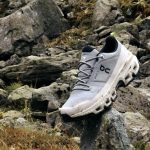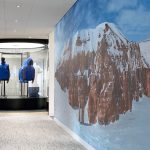While fashion trends in apparel always receive a lot of attention at both Outdoor Retailer shows, and fashion certainly garnered the most attention at the most recent SIA show, this years OR Winter Market showed that the outdoor industry is still focused on it technical roots. In footwear, apparel, and hardgoods, there was some solid incremental innovation present at the show, with vendors telling more of a “performance first” story than they had at previous shows.
Technology is driving direction in new looks and profiles. Schoeller introduced the soft shell. Primaloft ushered in the trend of low-profile insulated jackets. The most recent trend in apparel, however, is riding on the back of age-old technology wool, a trend that is as much about the sustainability story as it is about features and benefits. This year saw the largest expansion of Merino wool products since SmartWool first introduced the material to the North American market. Many of the Merino-only niche brands considerably expanded their product offering, while other larger players are looking at Merino as a viable category extension.
Icebreaker, considered to be the original Merino brand, extended into outerwear for the first time this year. The company has been on a steep growth curve since it created its own U.S. subsidiary two years ago, and this year reported a 300% increase in sales to U.S. retailers. With the launch of its new Coastal line with company is entering the outerwear market with 100% windproof Merino outerwear designed for the urban-adventure lifestyle.
SmartWool, is also entering the outerwear market for the first time with its new synergy line. This introduction is probably just the first step in SmartWools move into the outerwear category. Shortly after the company was acquired by Timberland, management made several comments about the opportunities available for the SmartWool brand in this category. While there will certainly be a few hiccups, SmartWool seems to be embracing the recent deal with Timberland with open arms. One executive told BOSS that the biggest change has been better insurance and a company-issued PDA.
Ibex has been producing its own line of Merino outerwear for several years (see BOSS_0608) with a decidedly more technical slant. The company offers a full line, ranging from base-layers to soft shells.
Patagonia is also getting into the Merino wool game, but true to form, the company is taking its environmental message into the category. Patagonia developed a new “slow wash” process that effectively eliminates chlorine from the cleaning cycle of Merino production. Patagonia introduced a full line of Merino base layers using this technology.
In footwear there are also several new innovations that are driving more customers into specialty retailers. Recently there has been unprecedented growth in the running category, at both outdoor retail and running specialty retail. With roughly 1,500 running specialty retailers across the country, many outdoor companies are looking at this market as a potential growth sector. These retailers are noticing also, with many of them attending Outdoor Retailer in lieu of other trade shows.
Innov8 is a small British footwear company that was launched in June of 2003 in the U.K. and then quickly jumped over to the U.S. in 2004. The product is definitely something new, with a focus on high performance trail running and outdoor athletes and a clear less-is-more design principle. The companys primary focus is on creating trail running race shoes for nearly any condition with very low and inherently stable foot platforms. In some models, the company uses light posting, but they are believers in the same school of thought that created the Nike Free, barefoot is better. Innov8 also recently received a license from Gore-Tex and has created their first line of waterproof-breathable footwear as well as an integrated and removable gaiter system.
The same company that is distributing Craft apparel in North America, The Europa Company, is now distributing Karhu footwear. Karhu has a rather interesting history. The company was established in 1916 and slowly became a leading supplier of athletic footwear to Olympic track & field athletes. The companys products were distinguished by its three stripe logo, which was sold to Adi Dassler for two bottles of good whisky and 1,600 in the 1950s. Today Karhu is collaborating with cutting edge researchers to develop new running technology that relies on the natural roll of the foot to increase efficiency. While Karhus parent company has no official ties to Crafts parent company, The Europa Company has been able to get both companies to cross merchandise colors between footwear and apparel.
Hi-Tec has continued its partnership with eVent for a new push into winter product. Hi-Tec is also returning to the trail running category and worked closely with Vibram to create a new outsole to suit their needs. Hi-Tecs designers created two different mid-soles with four different densities of cushioning to address different runners needs, one for those with a neutral gait and one that is posted for pronators. Hi-Tec continues to be very methodical about their brands re-positioning and has seen average selling prices continually climb as a result. Ten years ago the companys best-selling boot was $50 and today it is over $80. They have also narrowed their line down considerably last year they had over 300 styles and today there are 110.
Scarpa is now under its own dedicated management team in North America, and the company has expanded its offering considerably, especially in the light hiking, backpacking and light mountaineering categories. Under its new wholly-owned subsidiary, the company was able to offer prices that are 8% to 15% less than previous pricing. The company is seeing solid sell-in with its new line and is expecting a substantial increase in sales but is also trying to slightly reduce the number of doors in 2006.
Black Diamond is continuing with its telemark and alpine touring boot project that was initiated shortly after parting ways with Scarpa. Peter Metcalf, BDEs CEO, said that they created a six-person team to design the new product, and while it is a very big task to get this category off of the ground, he feels that there are a fair number of European and Asian factories that have the ability to produce this type of boot. Retailers should see the first BDE branded ski boots for Fall/Winter 07. Black Diamond is also segmenting their marketing strategies to accommodate the split market. Metcalf feels that the traditional climbing market responds better to a cleaner more refined message while bouldering and backcountry skiers enjoy the rogue image.
Mr. Metcalf also told BOSS that 2005 was the strongest year for the company in five years with double digit growth across the board. Europe outpaced the U.S. by a small margin, but both areas still reported sales increases in excess of 10%.
Jetboil is addressing the widespread demand for the company to make a more versatile cooking system with their new Group Cooking System, which compliments their previous Personal Cooking System. The GCS uses a 1.5 Liter Pot with JetBoils proprietary heat exchanger built into the bottom. This makes the system 80% more fuel efficient than stand-alone pots and stoves and it displaces heat across the bottom of the pot more evenly. The company has also invested in new POP materials for their retailers that highlights the entire line in one compact location.
Osprey launched a new line of ski packs this year, catering more and more specialized consumers and retailers with the Switch series. The company used its numerous athletes to help redesign the packs from the ground up. Osprey is also looking at the travel and adventure travel market with its Meridian series of luggage.
Gregory also launched two new ski packs at ORWM. The company feels that it is addressing the needs of the end user more accurately by creating very highly specialized products. At the same time these products appeal more to the aspirational skier, mountaineer, or climber. The strategy appears to be working as well, Paul Gagner, Gregorys VP of sales and marketing told BOSS that they have seen sales grow 16% over the past year while the overall backpack market continues to shrink.
Part of this growth comes from Gregorys push into the lifestyle market. The brand already has a huge following of commuters in Japan, with nearly 45% of their annual sales derived from this market. In North America, the company is specifically and aggressively targeting the womens market for lifestyle outdoor-inspired bags and packs. Gagner feels that the only company to really do a good job with this market is TimBuk2 and there is still opportunity for other brands.
Meanwhile, Timbuk2 continues to use its bike messenger heritage to inspire product design. The year the company launched its Single-Speed collection, a line of musette-inspired retro courier bags with details like toe-clip strap buckles and natural canvas. The company also launched a line of day packs designed for urban commuters.
Mammut is pushing avalanche safety to a new level with its new Barryvox Pulse digital transceiver, which actually provides data that can determine if an avalanche victim is alive. This is a key feature in the event of multiple burials where the ability to triage victims before digging will certainly save lives. The Pulse also offers a 360º display and a 3rd antennae for more accurate readings.














